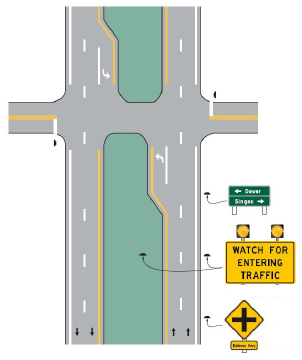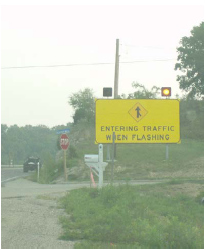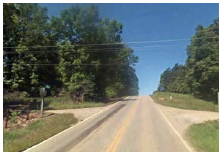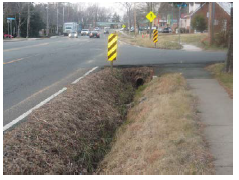U.S. Department of Transportation
Federal Highway Administration
1200 New Jersey Avenue, SE
Washington, DC 20590
202-366-4000
Safety improvement treatments on vertical curves range from low-cost improvements (such as signing) to high-cost improvements (such as modifying road geometry). This section covers safety improvement treatments that can be applied at vertical curve locations. Some treatments in this section also appear in the sections on intersection improvements, signing, and roadside safety.
| Safety Treatment | For more information, visit page | Cost | Frequency of Maintenance (years) | Safety Benefit | Benefit Cost Ratio38 | |||||
|---|---|---|---|---|---|---|---|---|---|---|
| Initial Implementation | Ongoing Maintenance | NCHRP 500 Performance Rating | Crash Modification Factor (CMF) | Lower Volume*, Optimal Conditions*** | Higher Volume**, Optimal Conditions*** | Lower Volume*, Narrower Conditions**** | Higher Volume**, Narrower Conditions**** | |||
| Install Advanced Intersection Warning Signs | 143 | $ | P | |||||||
| Install Dynamic Advanced Intersection Warning System | 144 | $$ | P | 0.10-0.76 | ||||||
| Modify Horizontal/Vertical Geometry | 145 | $$$$$ | P | |||||||
| Relocate Driveways, Entrances, and Intersections | 146 | $$$$$ | T | |||||||
Cost: NCHRP 500 Performance rating39 *Lower Volume ≤ 1000 vpd |
||||||||||
Advanced intersection warning signs can help alert drivers to the presence of an intersection ahead. Signs can be placed with sufficient distance prior to the intersection to allow drivers to perceive and react. They can also be installed on both sides of the roadway to solicit greater awareness.

Where to Use: Advanced intersection warning signs are to be applied predominantly on single through lane, high-crash, stop-controlled State intersections in both rural and urban areas. They may also be applied on dual through lane, high-crash, stop-controlled intersections with lower traffic volumes (less than about 25,000 average annual daily traffic (AADT)) where the use of J-treatments is not appropriate and the frequency of acceptable gaps for entering traffic is such that long waiting and higher risk taking are present at the intersection.
| Safety Treatment | Initial Implementation Cost | NCHRP 500 Performance Rating |
|---|---|---|
| Install Advanced Intersection Warning Signs | $0 to $5,000 | Tried |
Top Recommended Resources:
1. FHWA, Example Intersection Safety Implementation Plan, 2009.
2. FHWA, Stop-Controlled Intersection Safety: Through Route Activated Warning Systems, February 2011.
Infrastructure-based Intelligent Transportation System (ITS) technologies can be used to significantly improve the safety at stop-controlled intersections. These systems provide enhanced safety warning information for approaching drivers compared to passive warning systems. A dynamic advanced intersection warning system can provide:

Where to Use: This treatment may be provided at intersections that experience severe intersection-related crashes due to speed, low visibility, or insufficient gaps.
| Safety Treatment | Initial Implementation Cost | NCHRP 500 Performance Rating | Crash Modification Factor (CMF) |
|---|---|---|---|
| Install Dynamic Advanced Intersection Warning System | $5,001 to $20,000 | Proven | 0.10-0.76 |
Top Recommended Resource:
1. FHWA, Stop-Controlled Intersection Safety: Through Route Activated Warning Systems, February 2011. Available at: http://safety.fhwa.dot.gov/intersection/resources/fhwasa11015/traws.pdf.
Horizontal and vertical geometry may be reconstructed in a variety of ways. For example, horizontal and vertical curves may benefit from increased radii, thereby increasing sight distance. Modifying road geometry may also include eliminating horizontal or vertical curves and providing a more direct alignment.
Where to Use: This treatment may be used at locations where improved sight distance is needed and at locations that experience head-on collisions and run-off-road crashes. This treatment can also be used at unsignalized intersections with restricted sight distance due to horizontal or vertical geometry and those with patterns of crashes related to that lack of sight distance that cannot be ameliorated by less expensive methods.
| Safety Treatment | Initial Implementation Cost | NCHRP 500 Performance Rating |
|---|---|---|
| Modify Horizontal/Vertical Geometry | $100,001 and up | Proven |
Relocating or removing private and public driveways, commercial entrances, and road or street intersections just beyond the crest of vertical curves in the direction of travel isn't always feasible but does ensure that conflicts at locations with limited sight distances are removed or remediated.

Where to use: This treatment may be used near vertical curve crests where sight distance to driveways, entrances, or intersections is limited or obstructed.
| Safety Treatment | Initial Implementation Cost | NCHRP 500 Performance Rating |
|---|---|---|
| Relocate Driveways, Entrances, and Intersections | $100,001 and up | Tried |
Treatments in this section may be applied at specific locations to improvement safety and do not fit into any of the previous categories.
| Safety Treatment | For more information, visit page | Cost | Frequency of Maintenance (years) | Safety Benefit | Benefit Cost Ratio40 | |||||
|---|---|---|---|---|---|---|---|---|---|---|
| Initial Implementation | Ongoing Maintenance | NCHRP 500 Performance Rating | Crash Modification Factor (CMF) | Lower Volume*, Optimal Conditions*** | Higher Volume**, Optimal Conditions*** | Lower Volume*, Narrower Conditions**** | Higher Volume**, Narrower Conditions**** | |||
| Mitigate Ground Water to Prevent Ponding and/or Icing | 148 | $$$-$$$$ | E | |||||||
| Widen Functionally Obsolete Bridges | 149 | $$$$$ | ||||||||
Cost: NCHRP 500 Performance rating41 *Lower Volume ≤ 1000 vpd |
||||||||||
Good site drainage is needed to keep ponding and icing from occurring. This can be accomplished through a change in runoff conditions, whether by increasing the storm drainage capacity, re-grading ditches for better flow, or making changes to the roadway superelevation.

Where to Use: This treatment is applicable at locations where roadway ponding occurs.
| Safety Treatment | Initial Implementation Cost | NCHRP 500 Performance Rating |
|---|---|---|
| Mitigate Ground Water to Prevent Ponding and/or Icing | $20,001 to $100,000 | Experimental |
Widening narrow bridges on HRRR that are unable to accommodate traffic, either as a one-lane two-way operation or lanes too narrow to accommodate two-way traffic, may help to prevent head-on and sideswipe collisions.
Where to Use: This treatment can be used at locations that experience a high frequency of head-on or sideswipe collisions due to narrow lane width or one-lane two-way operations.
| Safety Treatment | Initial Implementation Cost |
|---|---|
| Widen Functionally Obsolete Bridges | $100,001 and up |
38 As discussed in Section 1.2, a BCR is only shown where data were available to calculate the ratio. Where data were unavailable, the BCR has been left blank. [ Return to note 38. ]
39 As stated in NCHRP Series 500 Reports (http://safety.transportation.org/guides.aspx). Proven: The safety effect for other similar applications has shown a proven benefit. Tried: The treatment has indications that it can be expected to reduce crashes, but has some conflicting reports as to its associated safety effects or has been deployed and observed to be effective. Experimental: New treatments that still need to be tested and for which the safety effect is unknown. Unknown: Not enough is known about an associated safety performance. [ Return to note 39. ]
40 As discussed in Section 1.2, a BCR is only shown where data were available to calculate the ratio. Where data were unavailable, the BCR has been left blank. [ Return to note 40. ]
41 As stated in NCHRP Series 500 Reports (http://safety.transportation.org/guides.aspx). Proven: The safety effect for other similar applications has shown a proven benefit. Tried: The treatment has indications that it can be expected to reduce crashes, but has some conflicting reports as to its associated safety effects or has been deployed and observed to be effective. Experimental: New treatments that still need to be tested and for which the safety effect is unknown. Unknown: Not enough is known about an associated safety performance. [ Return to note 41. ]
